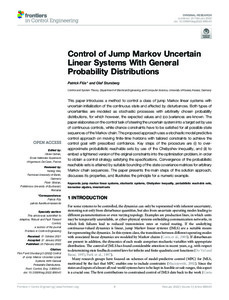| dc.date.accessioned | 2022-06-03T11:18:39Z | |
| dc.date.available | 2022-06-03T11:18:39Z | |
| dc.date.issued | 2022-02-25 | |
| dc.identifier | doi:10.17170/kobra-202205176196 | |
| dc.identifier.uri | http://hdl.handle.net/123456789/13892 | |
| dc.description.sponsorship | Gefördert durch den Publikationsfonds der Universität Kassel | ger |
| dc.language.iso | eng | eng |
| dc.rights | Namensnennung 4.0 International | * |
| dc.rights.uri | http://creativecommons.org/licenses/by/4.0/ | * |
| dc.subject | jump markov linear systems | eng |
| dc.subject | stochastic systems | eng |
| dc.subject | Chebyshev inequality | eng |
| dc.subject | probabilistic reachable sets | eng |
| dc.subject | kronecker algebra | eng |
| dc.subject | invariant sets | eng |
| dc.subject.ddc | 510 | |
| dc.title | Control of Jump Markov Uncertain Linear Systems With General Probability Distributions | eng |
| dc.type | Aufsatz | |
| dcterms.abstract | This paper introduces a method to control a class of jump Markov linear systems with uncertain initialization of the continuous state and affected by disturbances. Both types of uncertainties are modeled as stochastic processes with arbitrarily chosen probability distributions, for which however, the expected values and (co-)variances are known. The paper elaborates on the control task of steering the uncertain system into a target set by use of continuous controls, while chance constraints have to be satisfied for all possible state sequences of the Markov chain. The proposed approach uses a stochastic model predictive control approach on moving finite-time horizons with tailored constraints to achieve the control goal with prescribed confidence. Key steps of the procedure are (i) to over-approximate probabilistic reachable sets by use of the Chebyshev inequality, and (ii) to embed a tightened version of the original constraints into the optimization problem, in order to obtain a control strategy satisfying the specifications. Convergence of the probabilistic reachable sets is attained by suitable bounding of the state covariance matrices for arbitrary Markov chain sequences. The paper presents the main steps of the solution approach, discusses its properties, and illustrates the principle for a numeric example. | eng |
| dcterms.accessRights | open access | |
| dcterms.creator | Flüs, Patrick | |
| dcterms.creator | Stursberg, Olaf | |
| dc.relation.doi | doi:10.3389/fcteg.2022.806543 | |
| dc.subject.swd | Markov-Sprungprozess | ger |
| dc.subject.swd | Lineares System | ger |
| dc.subject.swd | Stochastisches System | ger |
| dc.subject.swd | Čebyšev-Approximation | ger |
| dc.subject.swd | Invariante Menge | ger |
| dc.type.version | publishedVersion | |
| dcterms.source.identifier | eissn:2673-6268 | |
| dcterms.source.journal | Frontiers in Control Engineering | eng |
| dcterms.source.volume | Volume 3 | |
| kup.iskup | false | |
| dcterms.source.articlenumber | 806543 | |


